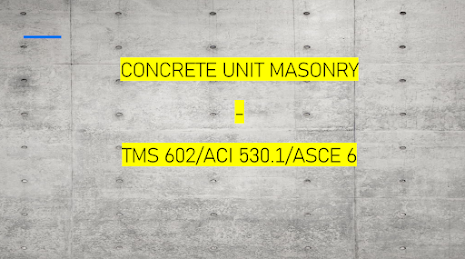Key requirement of TMS 602/ACI 530.1/ASCE 6 sections or related standards:
|
Component |
Type |
Minimum Strength Requirement |
Reference Standard |
|
Masonry Units (CMU) |
Concrete Masonry Units (CMU) |
2,000 psi (13.8 MPa) |
TMS 602/ACI 530.1/ASCE 6 Section
3 |
|
Masonry Units (Clay Bricks) |
Solid Clay Bricks |
2,500 psi (17.2 MPa) |
TMS 602/ACI 530.1/ASCE 6 Section
3 |
|
Masonry Units (Stone) |
Stone (e.g., limestone) |
2,000 psi to 3,000 psi (13.8 MPa to 20.7 MPa) |
TMS 602/ACI 530.1/ASCE 6 Section
3 |
|
Masonry Units (Lightweight) |
Lightweight Concrete Blocks |
1,500 psi (10.3 MPa) |
TMS 602/ACI 530.1/ASCE 6 Section
3 |
|
Mortar Strength |
Type M Mortar |
2,500 psi (17.2 MPa) |
TMS 602/ACI 530.1/ASCE 6 Section
4 |
|
Mortar Strength |
Type S Mortar |
1,800 psi (12.4 MPa) |
TMS 602/ACI 530.1/ASCE 6 Section
4 |
|
Mortar Strength |
Type N Mortar |
750 psi (5.2 MPa) |
TMS 602/ACI 530.1/ASCE 6 Section
4 |
|
Mortar Strength |
Type O Mortar |
350 psi (2.4 MPa) |
TMS 602/ACI 530.1/ASCE 6 Section
4 |
|
Grout Strength |
Fine Grout |
2,000 psi (13.8 MPa) |
TMS 602/ACI 530.1/ASCE 6 Section
5 |
|
Grout Strength |
Coarse Grout |
2,000 psi (13.8 MPa) |
TMS 602/ACI 530.1/ASCE 6 Section
5 |
|
Tensile Bond Strength |
Type M Mortar |
50 psi (0.34 MPa) |
TMS 602/ACI 530.1/ASCE 6 Section
4 |
|
Tensile Bond Strength |
Type S Mortar |
40 psi (0.28 MPa) |
TMS 602/ACI 530.1/ASCE 6 Section
4 |
|
Tensile Bond Strength |
Type N Mortar |
30 psi (0.21 MPa) |
TMS 602/ACI 530.1/ASCE 6 Section
4 |
|
Tensile Bond Strength |
Type O Mortar |
20 psi (0.14 MPa) |
TMS 602/ACI 530.1/ASCE 6 Section
4 |
|
Tensile Bond Strength |
Concrete Block (CMU) |
50 psi (0.34 MPa) |
TMS 602/ACI 530.1/ASCE 6 Section
4 |
|
Tensile Bond Strength |
Clay Brick |
40 psi (0.28 MPa) |
TMS 602/ACI 530.1/ASCE 6 Section
4 |
|
Reinforcement Strength |
Steel Reinforcement (Rebar) |
60,000 psi (413.7 MPa) minimum yield strength |
TMS 602/ACI 530.1/ASCE 6 Section
6 |
|
Shear Strength (Unreinforced) |
Unreinforced Masonry Wall |
100 psi (0.69 MPa) |
TMS 602/ACI 530.1/ASCE 6 Section
7 |
|
Shear Strength (Reinforced) |
Reinforced Masonry Wall |
300 psi (2.07 MPa) minimum, depending on
reinforcement |
TMS 602/ACI 530.1/ASCE 6 Section
7 |
Key Points
to Note:
- Masonry
Units: The minimum compressive strength
requirements for masonry units such as concrete blocks, clay
bricks, and stone are found in Section 3 of the code.
- Mortar:
Mortar strength requirements for different types (Type M, S, N, O) are
specified in Section 4.
- Grout: The
strength of fine and coarse grout is detailed in Section 5.
- Tensile
Bond Strength: The required bond strengths for various
types of mortar are also covered in Section 4.
- Reinforcement: The
specifications for reinforcement strength (e.g., rebar) are found in Section
6.
- Shear
Strength: The shear strength for both unreinforced
and reinforced masonry walls are mentioned in Section 7.
Let me know your comments with additional
details and clarifications below.





